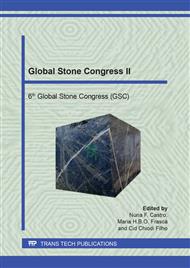[1]
European Commission, Closing the loop - An EU action plan for the Circular Economy. COM/2015/0614 final,, Brussels, (2015).
Google Scholar
[2]
European Commission, Communication from the Commission to the Council and the European Parliament - Integrated Product Policy. Building on Environmental Life-Cycle Thinking. Brussels, (2003).
Google Scholar
[3]
G. M. Nicoletti, B. Notarnicola, and G. Tassielli, Comparative Life Cycle Assessment of flooring materials : ceramic versus marble tiles,, J. Clean. Prod., vol. 10, p.283–296, (2002).
DOI: 10.1016/s0959-6526(01)00028-2
Google Scholar
[4]
M. Traverso, G. Rizzo, and M. Finkbeiner, Environmental performance of building materials : life cycle assessment of a typical Sicilian marble,, Int. J. Life Cycle Assess., p.104–114, (2010).
DOI: 10.1007/s11367-009-0135-z
Google Scholar
[5]
M. C. Torricelli and E. Palumbo, Measuring the sustainability of the sandstone of Firenzuola: the contribution of the life cycle assessment,, in Conference proceedings book - 1st international sustainable stone conference, 2016, p.10–12.
Google Scholar
[6]
M. Taxiarchou and I. Kostopoulou, Life Cycle Analysis of dimensional stones production,, in SDIMI 2007, (2007).
Google Scholar
[7]
N. Crishna, P. F. G. Banfill, and S. Goodsir, Resources , Conservation and Recycling Embodied energy and CO 2 in UK dimension stone,, Resour. Conserv. Recycl., vol. 55, no. 12, p.1265–1273, (2011).
DOI: 10.1016/j.resconrec.2011.06.014
Google Scholar
[8]
A. Gazi, G. Skevis, and M. A. Founti, Energy efficiency and environmental assessment of a typical marble quarry and processing plant,, J. Clean. Prod., vol. 32, p.10–21, (2012).
DOI: 10.1016/j.jclepro.2012.03.007
Google Scholar
[9]
D. Ioannidou, S. Zerbi, and G. Habert, When more is better - Comparative LCA of wall systems with stone,, Build. Environ., vol. 82, p.628–639, (2014).
DOI: 10.1016/j.buildenv.2014.10.004
Google Scholar
[10]
J. Catarino, J. Henriques, and A. Maia, Eco-efficiency in Portuguese companies of marble sector,, Int. J. Sustain. Eng., vol. 9, no. 1, p.33–44, (2016).
Google Scholar
[11]
M. Castoldi Borlini Gadioli, N. Fernández Castro, A. De Andrade Pazeto, C. E. Ribeiro Wandermurem, P. Fernandes de Almeida, and D. Pimentel Tavares, Life-Cycle Inventory of Dimension Stones , Brazil,, in Proceedings of Global Stone Congress 2012, (2012).
Google Scholar
[12]
J.-M. F. Mendoza, M. Feced, G. Feijoo, A. Josa, X. Gabarrell, and J. Rieradevall, Life cycle inventory analysis of granite production from cradle to gate,, Int. J. Life Cycle Assess., vol. 19, no. 1, p.153–165, (2014).
DOI: 10.1007/s11367-013-0637-6
Google Scholar
[13]
J.-M. F. Mendoza, C. Capitano, G. Peri, A. Josa, J. Rieradevall, and X. Gabarrell, Environmental management of granite slab production from an industrial ecology standpoint,, J. Clean. Prod., vol. 84, p.619–628, (2014).
DOI: 10.1016/j.jclepro.2014.03.056
Google Scholar
[14]
S. Bai, J. Zhang, and Z. Wang, Selection of a sustainable technology for cutting granite block into slabs,, J. Clean. Prod., vol. 112, p.2278–2291, (2016).
DOI: 10.1016/j.jclepro.2015.10.052
Google Scholar
[15]
European Commission, ILCD Handbook - General Guide for Life Cycle Assessment - Detailed Guidance,, Ispra (VA) Italy, (2010).
Google Scholar
[16]
The International Standards Organisation, Environmental management — Life cycle assessment — Principles and framework,, Iso 14040, vol. 2006, p.1–28, (2006).
Google Scholar
[17]
The International Standards Organisation, Environmental management — Life cycle assessment — Requirements and guidelines,, ISO 14044, vol. 2006, no. 7, p.652–668, (2006).
DOI: 10.3403/30290345
Google Scholar
[18]
P. Primavori, Pianeta Pietra. (1999).
Google Scholar
[19]
P. Primavori, I materiali lapidei della Sardegna, 1st ed. Sardegna Ricerche, (2011).
Google Scholar
[20]
M. Cardu, Analysis of the Excavation Techniques to Optimize the productivity in an Italian Dimension Stone Basin,, in Diamante. Applicazioni & Tecnologia, 2012, p.115–124.
Google Scholar
[21]
M. Cardu, Analisi delle tecniche estrattive adottate in un bacino italiano di pietra ornamentale per ottimizzare la produttività,, Diamante. Applicazioni & Tecnologia, vol. 18, no. 72, p.55–65, (2013).
Google Scholar
[22]
A. Giuffrida, I materiali lapidei tradizionali nell'architettura contemporanea . La pietra di Siracusa.,, Università degli Studi di Catania, (2010).
Google Scholar
[23]
A. Masciullo, Valutazione ambientale di prodotti lapidei per le costruzioni. Applicazione al caso studio della pietra Leccese e proposte per la sua valorizzazione,, Università degli Studi di Firenze, (2016).
DOI: 10.36253/978-88-6655-307-6
Google Scholar


